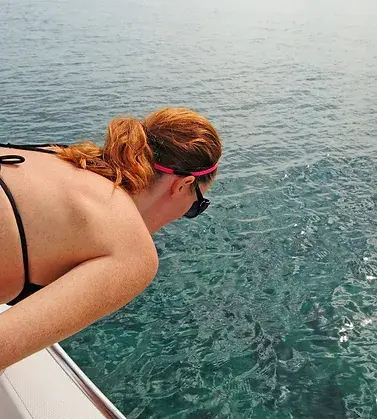Celebrating 5 years in business we thought we would share some of our secrets..
- Dudley Jackson

- Nov 20
- 3 min read

World-first exploration of VIRTUAL REALITY as a seasickness solution.
Real physiological evidence: 15 bpm heart-rate spike before sickness and 15 bpm drop after VIRTUAL REALITY application
Rapid effect: VIRTUAL REALITY removed symptoms in 12 minutes.
Real-world testing in Antarctica and across commercial whale-watching vessels.
Technical innovation: motion-injection system and custom-built VIRTUAL REALITY simulator.
High user success rate, with most passengers needing only a single application. 1. Early Concept (2019): Exploring VIRTUAL REALITY as a Seasickness Solution
In 2019, the idea of using virtual reality to alleviate seasickness was entirely new. The team had to answer several major, previously unexplored questions:
Key Questions We Set Out to Answer
Can VIRTUAL REALITY genuinely counteract motion sickness at sea?
How quickly would VIRTUAL REALITY take effect?
Would it work across different sea conditions, vessel types, and user demographics?
Could it be engineered into a reliable med-tech device for real-world use?
These challenges formed the foundation of all future R&D and marked the beginning of a completely new approach to seasickness management.
2. Early Hardware Limitations & Lessons Learned
At the time, VIRTUAL REALITY headset technology was still maturing:
Key Issues with 2019 VIRTUAL REALITY Technology
Most VIRTUAL REALITY headsets were tethered to PCs, unsuitable for marine environments.
The Oculus Go was the first promising stand-alone headset with decent battery life and portability.
Mobile phone VIRTUAL REALITY systems (e.g., Gear VIRTUAL REALITY) proved impractical:
If users weren't prepared ahead of time, the setup delay and phone insertion process could worsen seasickness.
Important Breakthrough
Testing during a 10-day Antarctic voyage was pivotal:
Delivered outstanding results in real seasickness scenarios.
Revealed how passengers behave when actively seasick.
Showed how quickly or slowly people adopt new technology under stress.
One limitation: Oculus did not allow any hardware modifications, leading to exploration of other platforms like Pico Interactive, which offered more flexibility and ease of use.
3. Training the Body to Adapt Faster: Motion-Injection R&D
The next phase involved researching whether VIRTUAL REALITY could accelerate the body’s natural adaptation to vessel motion (normally a three-day process).
Core R&D Project
Recorded vessel movement data (yaw, pitch, roll).
Injected this data into the VIRTUAL REALITY scene to adjust the user’s visual environment in real time.
Created controlled “training” environments to gradually increase motion exposure.
Key Findings
The system showed some success, but adaptation still took time for certain individuals.
The process was expensive and technically complex.
However, it revealed extremely valuable data about:
Which wave patterns trigger seasickness,
Which motions are most destabilising,
How users respond over time.
Major R&D Efficiency Boost
Alexander joined as lead developer, creating an in-office simulator that could test these VIRTUAL REALITY motion conditions:
Reduced testing cycles from days to minutes.
Saved significant subcontracting costs.
Allowed rapid, iterative experimentation. See the Simulator here: Video https://www.facebook.com/share/v/1BkNHdpK7H/
4. Physiological Verification: Live Testing at Sea
To collect real physiological data, volunteers were taken on a 6-meter powerboat for half-day trials from Lyttelton Harbour into the Pacific Ocean under strong roll-wave conditions known to induce seasickness.
Heart-Rate Discoveries
Heart rate consistently increased by ~15 bpm just before the onset of vomiting.
This created a predictive biomarker for seasickness onset.
When participants applied the See-LEVEL headset at this peak:
Our system also worked alongside existing medication if previously taken prior.
This became the first documented physiological evidence that VIRTUAL REALITY could rapidly reverse seasickness symptoms.
Trip to Antarctica client testimonial – Drake Passage https://www.youtube.com/watch?v=OzASj8P3Wrc
5. Real-World Validation: 18-Month Commercial Deployment
A major New Zealand whale-watching operator used multiple See-LEVEL headsets for 18 months, generating insights based on hundreds of passenger experiences.
Key Observations
Early application produced the most reliable results.
Most users required only one session and remained stable for the entire 2.5-hour trip.
A minority of users re-triggered their seasickness by:
Taking photos,
Looking at phones or cameras.
These individuals usually needed one or two additional applications
Client Testimonial Video https://www.youtube.com/watch?v=ByZQGtrHRsc
A tiny percentage of passengers—those with underlying medical or vestibular conditions—were inherently extremely motion-sensitive and became seasick regardless of intervention.
Even for them, See-LEVEL still provided partial relief.
Video Evidence - https://www.youtube.com/watch?v=s7x5jKnjac4
https://www.youtube.com/watch?v=HjlC9hrQGL4
https://www.youtube.com/watch?v=pkHsqa6qRvI
6. A Significant Volunteer: Captain Chris Coleman (Port Pilot)
During public volunteer testing, one participant turned out to be Captain Chris Coleman, the local Port Pilot—the highest qualification achievable in maritime operations.
Why This Was Important
Chris had begun suffering from seasickness later in life, something he said was brought on simply by ageing.
He quietly joined the test session without announcing who he was.
He experienced immediate, powerful relief using See-LEVEL.
He was so impressed that he:
Offered to deploy See-LEVEL on the port’s pilot vessels, and
Volunteered to appear on national prime-time television to share this discovery publicly. www.youtube.com/watch?v=0MNxEEYeuQ8&t
_edited.png)



Comments